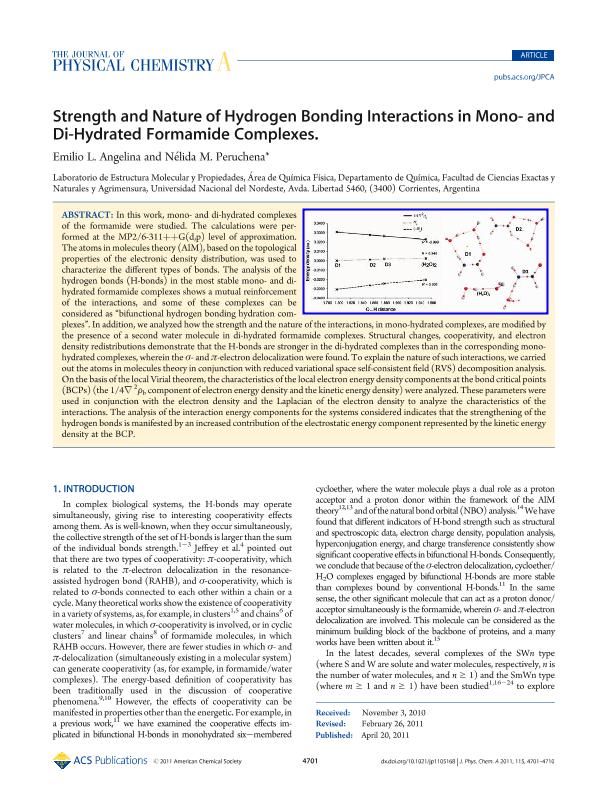Mostrar el registro sencillo del ítem
dc.contributor.author
Angelina, Emilio Luis

dc.contributor.author
Peruchena, Nelida Maria

dc.date.available
2017-03-31T19:19:19Z
dc.date.issued
2011-04
dc.identifier.citation
Angelina, Emilio Luis; Peruchena, Nelida Maria; Strength and nature of hydrogen bonding interactions in mono- and di-hydrated formamide complexes; American Chemical Society; Journal of Physical Chemistry A; 115; 18; 4-2011; 4701-4710
dc.identifier.issn
1089-5639
dc.identifier.uri
http://hdl.handle.net/11336/14630
dc.description.abstract
In this work, mono- and di-hydrated complexes of the formamide were studied. The calculations were performed at the MP2/6-311++G(d,p) level of approximation. The atoms in molecules theory (AIM), based on the topological properties of the electronic density distribution, was used to characterize the different types of bonds. The analysis of the hydrogen bonds (H-bonds) in the most stable mono- and di-hydrated formamide complexes shows a mutual reinforcement of the interactions, and some of these complexes can be considered as “bifunctional hydrogen bonding hydration complexes”. In addition, we analyzed how the strength and the nature of the interactions, in mono-hydrated complexes, are modified by the presence of a second water molecule in di-hydrated formamide complexes. Structural changes, cooperativity, and electron density redistributions demonstrate that the H-bonds are stronger in the di-hydrated complexes than in the corresponding mono-hydrated complexes, wherein the σ- and π-electron delocalization were found. To explain the nature of such interactions, we carried out the atoms in molecules theory in conjunction with reduced variational space self-consistent field (RVS) decomposition analysis. On the basis of the local Virial theorem, the characteristics of the local electron energy density components at the bond critical points (BCPs) (the 1/4∇ 2ρb component of electron energy density and the kinetic energy density) were analyzed. These parameters were used in conjunction with the electron density and the Laplacian of the electron density to analyze the characteristics of the interactions. The analysis of the interaction energy components for the systems considered indicates that the strengthening of the hydrogen bonds is manifested by an increased contribution of the electrostatic energy component represented by the kinetic energy density at the BCP.
dc.format
application/pdf
dc.language.iso
eng
dc.publisher
American Chemical Society

dc.rights
info:eu-repo/semantics/openAccess
dc.rights.uri
https://creativecommons.org/licenses/by-nc-sa/2.5/ar/
dc.subject
Charge Density
dc.subject
Formamide
dc.subject
Rvs
dc.subject
Electronic Energy Density
dc.subject
Hydrogen Bonds
dc.subject
Aim
dc.subject.classification
Físico-Química, Ciencia de los Polímeros, Electroquímica

dc.subject.classification
Ciencias Químicas

dc.subject.classification
CIENCIAS NATURALES Y EXACTAS

dc.title
Strength and nature of hydrogen bonding interactions in mono- and di-hydrated formamide complexes
dc.type
info:eu-repo/semantics/article
dc.type
info:ar-repo/semantics/artículo
dc.type
info:eu-repo/semantics/publishedVersion
dc.date.updated
2017-03-30T18:22:36Z
dc.journal.volume
115
dc.journal.number
18
dc.journal.pagination
4701-4710
dc.journal.pais
Estados Unidos

dc.journal.ciudad
Washington
dc.description.fil
Fil: Angelina, Emilio Luis. Universidad Nacional del Nordeste. Facultad de Cs.exactas Naturales y Agrimensura. Departamento de Quimica. Laboratorio de Estructura Molecular y Propiedades; Argentina. Consejo Nacional de Investigaciones Científicas y Técnicas; Argentina
dc.description.fil
Fil: Peruchena, Nelida Maria. Universidad Nacional del Nordeste. Facultad de Cs.exactas Naturales y Agrimensura. Departamento de Quimica. Laboratorio de Estructura Molecular y Propiedades; Argentina. Consejo Nacional de Investigaciones Científicas y Técnicas; Argentina
dc.journal.title
Journal of Physical Chemistry A

dc.relation.alternativeid
info:eu-repo/semantics/altIdentifier/url/http://pubs.acs.org/doi/abs/10.1021/jp1105168
dc.relation.alternativeid
info:eu-repo/semantics/altIdentifier/doi/http://dx.doi.org/10.1021/jp1105168
Archivos asociados
